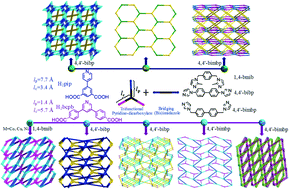Syntheses, structures, and properties of a series of 2D and 3D coordination polymers based on trifunctional pyridinedicarboxylate and different (bis)imidazole bridging ligands†
Abstract
A series of 2D and 3D transition coordination polymers (CPs), {[M(bcpb)(1,4-bmib)0.5]·xH2O}n (M = Co (1), Cu (2), Ni (3), x = 1 for 1, 0 for 2 and 3), {[Co(bcpb)(4,4′-bibp)0.5(H2O)1.5]·1.5H2O}n (4), [Cu(bcpb)(4,4′-bibp)0.5(H2O)]n (5), {[Ni(bcpb)(4,4′-bimbp)(H2O)]·2.5H2O}n (6), [Co(bcpb)(4,4′-bimbp)]n (7), [Mn(pip)(MeOH)(H2O)]n (8), {[Ni(pip)(4,4′-bibp)0.5(H2O)]·2H2O}n (9), and {[Cu(pip)(4,4′-bimbp)]·4H2O}n (10), were synthesized under hydrothermal conditions in the presence of two trifunctional pyridinedicarboxylates and different (bis)imidazole bridging linkers (H2bcpb = 3,5-bis(4-carboxyphenyl)pyridine, H2pip = 5-(4-pyridyl)isophthalic acid, 1,4-bmib = 1,4-bis(2-methylimidazol-1-ylmethyl)benzene), 4,4′-bibp = 4,4′-bis(imidazol-1-yl)biphenyl, 4,4′-bimbp = 4,4′-bis(imidazol-1-ylmethyl)biphenyl). Their structures have been determined by single-crystal X-ray diffraction analyses and further characterized by elemental analyses, IR spectra, powder X-ray diffraction (PXRD), and thermogravimetric (TG) analyses. Single crystal X-ray diffraction analyses reveal that complexes 1–3 are isomorphic and show complicated 3D (3,5)-coordinated amd networks, which could be viewed as two interpenetrated ths nets. Complex 4 is a binodal (3,4)-connected 3D framework with the Schläfli symbol of (4·72)(4·75·84). Complex 5 exhibits an intriguing 3D 2-fold interpenetrated network with the (3,4)-connected dmc net. Complex 6 is a 2D (3,5)-connected gek1 net with right- and left-handed [Ni(4,4′-bibp)]n helical chains arranged alternately. The 3D framework of 7 is defined as a 2-fold interpenetrated (3,5)-connected gra topology. Complex 8 displays a 2D 3-connected 63-hcb network. Complex 9 can be regarded as a (3,4)-coordinated crs-d network with a point symbol of (62·8)(63·8·102), which contains two interpenetrated 3-coordinated 103srs subnets linked by 2-coordinated 4,4′-bibp. Complex 10 is a binodal (3,5)-connected 3D framework with point Schläfli symbol of (4·6·8)(4·64·85). To the best of our knowledge, the 3D CPs with (3,4)-connected (4·72)(4·75·84) for 4, and (3,5)-connected (4·6·8)(4·64·85) for 10 have never been documented up to now. Moreover, the magnetic properties of 4 have been investigated.


 Please wait while we load your content...
Please wait while we load your content...